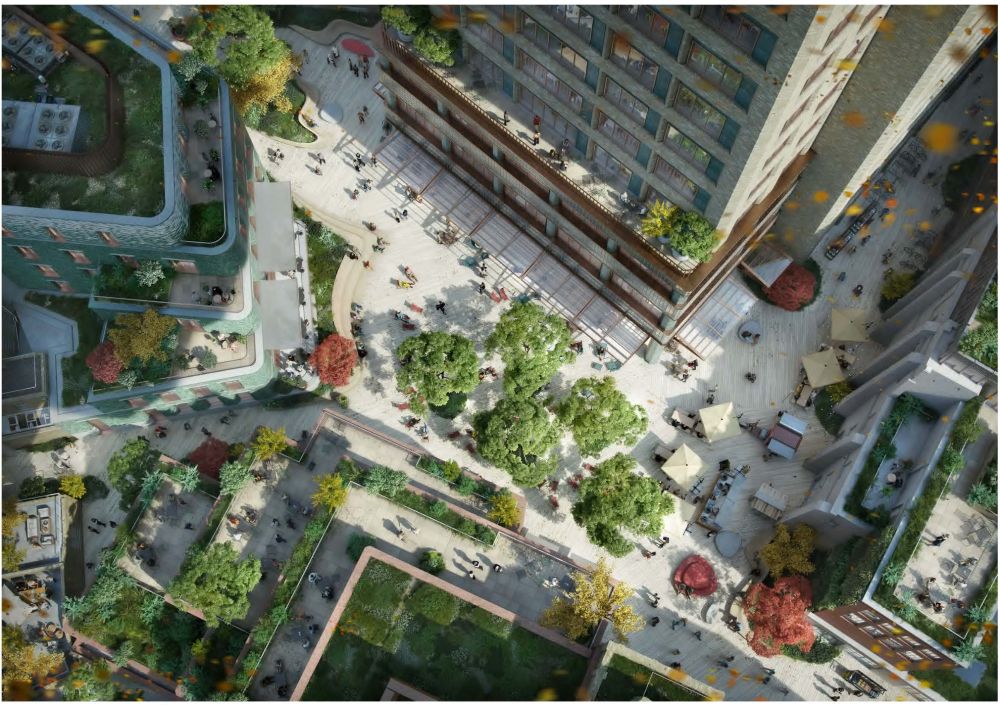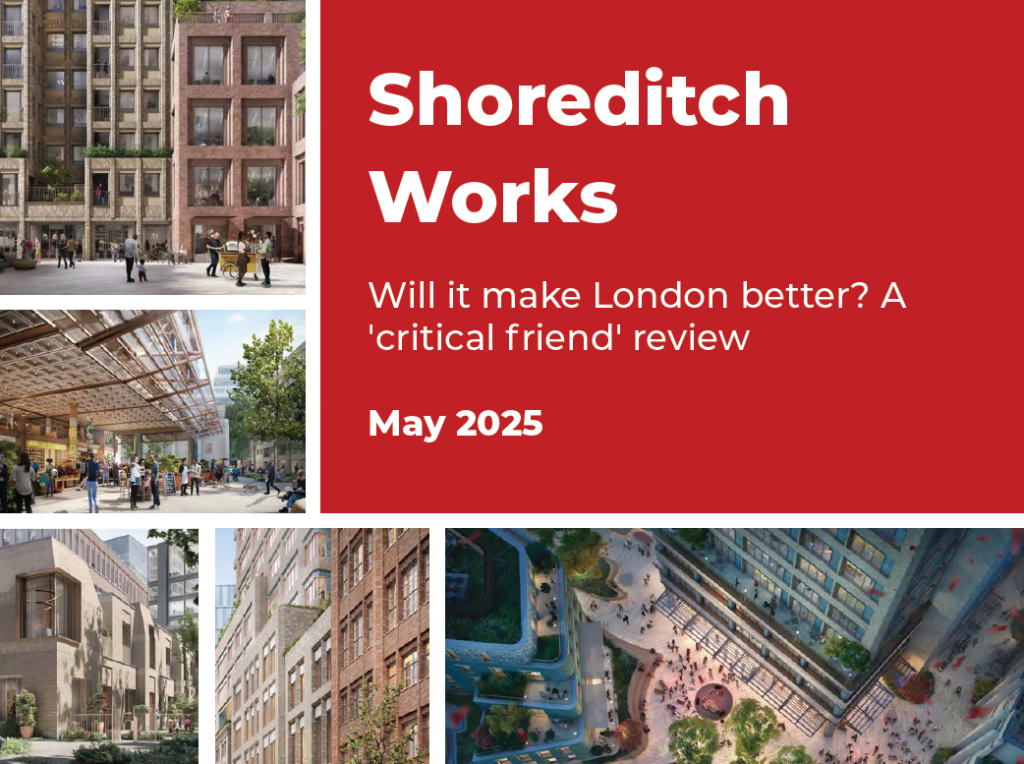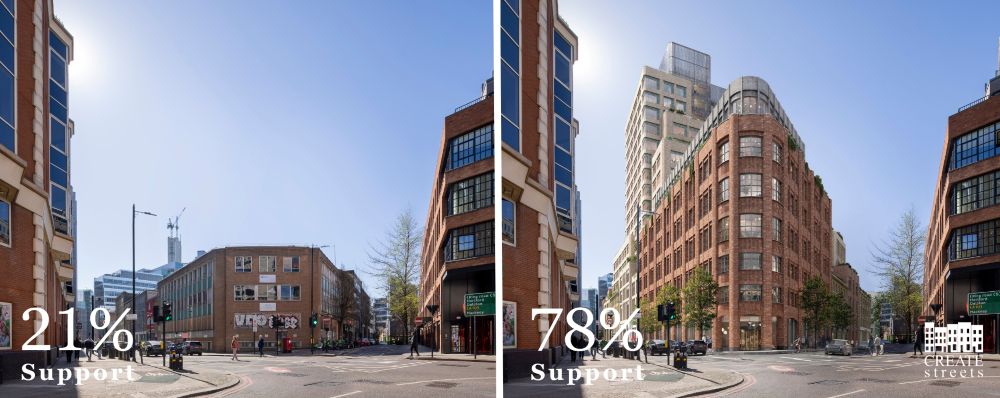Create Streets are today publishing our independent review of the Shoreditch Works development in Hackney, London. For full transparency, this report has been commissioned and paid for by Linea Properties. However, it is fully independent. Beyond provision for factual corrections, editorial control has remained completely with Create Streets throughout. You can read the full report here.
Our conclusion is that the scheme is an excellent example of urban regeneration and re-stitching that should improve the prosperity, quality of life, liveability and beauty of this corner of London. In the round, it is to be highly commended. It repairs design scars left over since the war and intensifies London in precisely the right place. Studying the design history, it has clearly improved through the preapplication process and the designers, consultants and Local Planning Authority deserve high praise.
Drawing on our extensive, award-winning and international research into relationships between design and movement with prosperity, health, happiness, popularity, and support for development, we assess that its key strengths include:
1. Creating a place that is very popular with the public across all demographics. Deltapoll conducted a statistically representative visual preference survey of the British public on behalf of Create Streets, sampling over two thousand respondents. The public were shown three pairs of before/after images showing existing conditions alongside proposed development views from identical angles, with carefully controlled variables including sky and lighting conditions, and foreground elements like cars and pedestrians. Respondents based preferences solely on visual comparisons, receiving no contextual information about the wider project beyond the paired images, ensuring unbiased assessment of the design placemaking and aesthetic qualities.
The results revealed considerable public support for the development’s streetscape improvements and the benefit to its surroundings, with support ranging from 76 to 78 percent. Support was strong across all demographics by age, socio-economic status and political views. Support was particularly strong among younger adults.
2. Material improvements to the attraction of the streetscape improving the height, texture, variety in a pattern and material quality of buildings facing Scrutton Street, Curtain Road, Hollywell Row and Worship Street. The scheme wisely and well maintains all buildings that already improve the street and improves all those that spoil it.
3. More than doubling the level of usable internal space for offices, shops and residential from 29,000 GEA sqm to 80,543 GIA sqm.
4. Providing well designed new public space and artfully designed linkages through the urban block. (These could be too much if it was a purely residential-led scheme but are perfectly appropriate in the circumstances).
5. Creating some superb, colourful and textured new buildings within the block as well as on the streets. Most notably the Mason Building, which picks up some excellent recent precedents such as 40 Beak Street and Buckle Street Studios and might even be said to be starting to create a new London typology.
6. Creating 78 new homes, 35 per cent of which will be affordable. London desperately needs homes, particularly when in such an excellently improved and well-connected place.
7. Funding improvements to the surrounding streetscape and public realm which are likely to be excellent given Hackney’s track record in this department. Hackney’s planting of over 5,000 new street trees has been exemplary.
8. Preserving and funding improvements to the important and attractive historic buildings, to all of the façades and most of the surviving interiors, above all important Webb Terrace which has been shabby for many years and will now finally be restored thanks to this scheme. This is hugely to be welcomed by anyone interested in London’s history.
9. Managing responsibly and well some of the challenges of wind and light that a higher density scheme and tall building unavoidably creates, notably the large bifold doors of the Verso Building and the setback above its urban room.
More widely, given the depressingly placeless, unpopular and bird-killing glass towers which have dominated most City and much City fringe development over the last 20 years resulting in heartless and windy streets, this is a very welcome departure from the norm, creating a new place which promises to rise above the windy and the dark. If delivered as promised it will massively improve the existing historic streets and the important Webb Terrace.

Our main concern and suggestion is (as we understand it) more a consequence of London and Hackney’s planning policy than a specific scheme design decisions. Given the desperate housing need in London and the relative adequacy of commercial space, we would have preferred to see a higher quantum of housing within the overall development. In the long-term however there is little to stop some of these buildings being repurposed to residential uses in generations to come. What is critical is repairing the damage of anti-street development two generations ago and creating better places for the future. This scheme achieves this superbly. We have several other points of detail, but these are second order compared to the scheme’s overall quality and almost inevitable in a scheme of this welcome scale and complexity.
Commenting on the reports finding, Create Streets’ founder and chairman, Nicholas Boys Smith, said:
“As we have done for schemes the length and breadth of the land, we examine the design at the three scales of Bird’s Eye (beyond the red line), Adult’s Eye (streets and geometry) and Child’s Eye (materials and design).
We set out the considerable merits and (as you will see) the few demerits of this excellent scheme. Every word is our own. The review shows, first and last, that when you make places better, people prefer it. Design is not subjective. There are predictable and fairly consistent relationships between how we design our streets and squares and the quality of the air we breathe, our propensity to walk, to speak to our neighbours and to feel safe as we move around our towns and cities.
What people like is also highly predictable. The results of our proprietary Visual Preference Survey could not be clearer: 76 to 78 per cent support over three carefully controlled image comparisons consistent across all demographics of age, politics and place.
This is the fastest path to growth: using new buildings to make old places better, as judged by the public. At present, only two per cent of the British public trust developers to improve existing places with their works. And only seven per cent trust the planning system. These are, to put it mildly, not good statistics. If the British are to fall back in love with the future and if we are to improve the productivity, prosperity and beauty of our existing towns and cities, then schemes like this must become the norm, not the exception. Let us hope that the planners and councillors of Hackney Council agree and that common sense, hope and ‘love of London’ can win the day.”
You can read the full report here.
You can read about our report in City AM here



